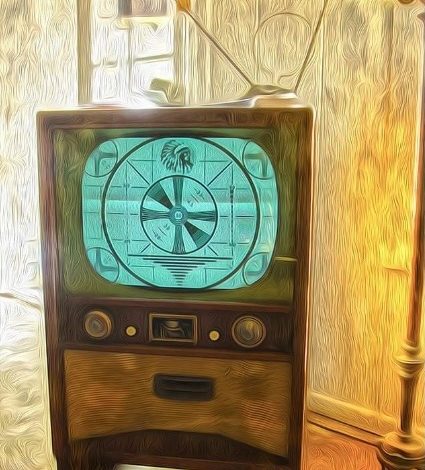
ADVERTISEMENT
The Evolution of Television: From Analog Beginnings to the Digital Age
Television, often referred to as the “boob tube” or “the idiot box,” has been a staple in homes around the world for decades. While today’s sleek, flat-screen TVs bear little resemblance to their bulky, wooden predecessors, the evolution of this technology has been nothing short of remarkable. The image of a vintage television with an analog test pattern on the screen evokes a sense of nostalgia, reminding us of how far we’ve come in the world of broadcasting and home entertainment.
ADVERTISEMENT
The Early Days of Television
The concept of television has been around since the early 20th century, but it wasn’t until the late 1940s and early 1950s that TV sets became common household items. The television in the image, with its rounded screen and wooden casing, is reminiscent of the models that were once the centerpiece of family living rooms.
These early televisions were analog, relying on radio waves to transmit signals from broadcasting stations to home receivers. The black-and-white images, often fuzzy and prone to interference, were groundbreaking at the time, offering viewers a window to the world from the comfort of their own homes.
The Significance of the Test Pattern
The test pattern displayed on the screen is a classic symbol from the analog era of television. Often referred to as the “Indian Head test pattern,” it was used by broadcasters to calibrate the picture and audio quality of their transmissions. In the early days of television, programming wasn’t available 24/7, so when stations were off the air, they would display this pattern to help technicians ensure that everything was functioning correctly.
This image is a reminder of the simpler times when television was just beginning to revolutionize the way people consumed information and entertainment.
The Transition to Color
As technology advanced, so did television. The 1960s saw the introduction of color TV, a monumental leap forward that forever changed the viewing experience. Shows like “The Wonderful World of Disney” and “Bonanza” became household favorites, offering vibrant colors that captivated audiences and made the monochrome days of early TV seem like a distant memory.
ADVERTISEMENT
The shift from black-and-white to color was not just about aesthetics; it represented the increasing sophistication of television technology and the growing importance of TV as a cultural medium.
The Digital Revolution
The next major evolution in television came with the digital revolution. Starting in the late 1990s and early 2000s, digital broadcasting began to replace analog signals, offering superior picture and sound quality. High-definition (HD) television became the new standard, followed by 4K and now 8K resolutions that provide crystal-clear images far beyond what early TV pioneers could have imagined.
Digital technology also paved the way for smart TVs, which integrate internet capabilities and allow viewers to stream content from services like Netflix, Hulu, and YouTube. The days of waiting for your favorite show to come on are long gone; now, viewers can watch what they want, when they want.
The Future of Television
As we look at the image of the vintage television, it’s fascinating to consider what the future holds for this ever-evolving medium. Virtual reality (VR) and augmented reality (AR) technologies are already beginning to make their mark, offering immersive viewing experiences that could redefine what it means to “watch TV.”
Moreover, with the rise of streaming platforms, the traditional model of television broadcasting is changing rapidly. Viewers now have more control than ever before, choosing from a vast array of content that’s accessible on-demand.
ADVERTISEMENT
Conclusion
The television in the image is more than just a piece of nostalgia; it’s a symbol of the incredible journey that this technology has undergone. From the grainy black-and-white broadcasts of the 1950s to the high-definition, on-demand experiences of today, television has continually adapted to the changing needs and desires of its audience.
As we stand on the cusp of new technological advancements, one thing is certain: television will continue to evolve, shaping and reshaping the way we connect with the world around us.




